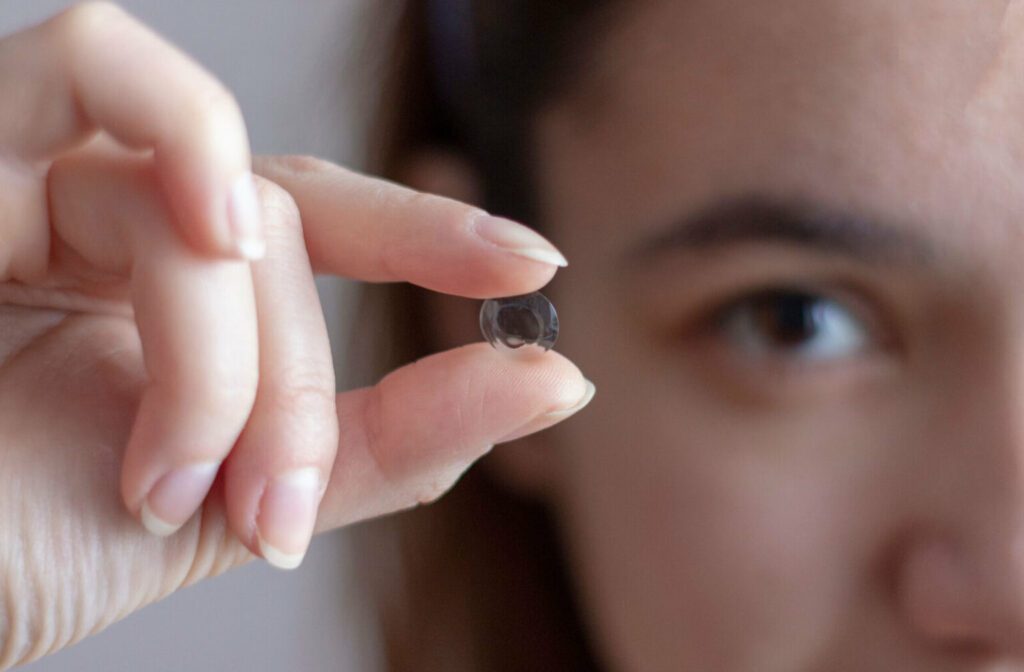Table of Contents

Introduction
Have you ever heard of ortho-k lenses? Your optometrist might’ve mentioned them as an alternative to eyeglasses or standard contact lenses to correct your vision. These are a special type of contact lens used to correct your vision while you sleep. That’s right; you may be able to correct your vision while you sleep!
Ortho-k lenses, also known as corneal reshaping lenses or vision-shaping lenses, are gas-permeable contact lenses that work by gently reshaping your cornea while you sleep. The cornea is the clear, dome-shaped surface at the front of your eye and is essential in focusing light for clear vision.
Ortho-k lenses can address nearsightedness, astigmatism, and farsightedness in both children and adults. They can even be part of a myopia control program for your child.
What Are Ortho-K Lenses?
Ortho-k lenses apply gentle pressure to your cornea as you sleep, which causes it to slightly flatten temporarily. This flattening changes the way light focuses on your retina. Since refractive errors, such as myopia, can be caused by your eye growing too long and your cornea having too much curve, this flattening may correct your vision.
It’s important to note the amount of flattening needed will depend on your, or your child’s, prescription. First, your optometrist will map and measure the surface of your cornea using a corneal topographer. This instrument reflects light off your eyes, giving the optometrist a cornea map. This map lets your optometrist create custom-designed lenses to ensure a proper fit.
The lenses themselves are gas-permeable, meaning that oxygen can pass through the lens and reach the cornea, which is essential for maintaining eye health. However, ortho-k lenses require some discipline to wear correctly. You or your child must wear the lenses every night to maintain the corneal reshaping effect, as your eyes will return to their original shape throughout the day.
You’ll typically notice an improvement in your vision within a few days to a few weeks.

Who Are Ortho-K Lenses For?
Ortho-k lenses are a great option for children and adults with myopia, also known as nearsightedness. Myopia is a common vision problem that causes distant objects to appear blurry while nearby objects remain clear. Studies have shown ortho-k lenses are safe and effective method of correcting myopia and providing clear vision without needing glasses or traditional contact lenses.
The effects of ortho-k lenses are reversible. If you stop wearing the lenses, your cornea gradually returns to its original shape, along with your vision. This reversibility might make it a good option for people who want to try it out before committing to a typically more permanent solution like LASIK.
Ortho-K for Myopia Control
In addition to correcting myopia, your child can use ortho-k lenses for myopia control.
Myopia is typically first diagnosed when you’re a child, usually between the ages of 6–14, according to the National Eye Institute. It can worsen until your child is 20, when it may stabilize. If left untreated, it can result in long-term vision problems and put your child at higher risk of developing severe eye conditions, such as:
- A detached retina
- Glaucoma
- Cataracts
Many optometrists recommend myopia control programs to slow myopia progression in children and teenagers. Ortho-k has been shown to be a helpful tool in management plans. One clinical trial showed wearing ortho-k lenses slowed myopia progression in some children by up to 56%.
Ortho-K for Astigmatism
While ortho-k lenses may be most known for correcting nearsightedness, they can also be a good option for people with mild to moderate astigmatism. Astigmatism is a general blurriness due to the eye taking on a more oval shape, rather than being round.
Since astigmatism can occur alongside myopia, having ortho-k lenses designed to address both conditions can be a great relief. These special ortho-k lenses are typically toric, meaning they have a non-spherical shape. Clinical studies have shown these irregularly shaped lenses might benefit people with both myopia and astigmatism.
Ortho-K for Farsightedness
Ortho-k lenses are typically used to correct nearsightedness, but your optometrist can also prescribe them to correct some levels of farsightedness, also known as hyperopia. This refractive error is effectively the opposite of myopia. It happens because your eye has stopped growing lengthwise and is too short, or your cornea is too flat. This results in nearby objects being blurry while faraway objects remain clear.
Your eye doctor can determine if ortho-k lenses are an option for your farsightedness based on your prescription and eye health.
Are You Looking for New Ortho-K Eye Doctor? 阿尔法角膜塑形镜
You may recognize ortho-k lenses as:
- ok镜
- 梦戴维
- 欧几里德 EUCLID
- 露晰得LUCID
- 阿尔法
- 菁视C&E
- 易安易E&E
- 亨泰
- Dreamlite
Our eye doctors at Golden Vision have extensive knowledge in providing and fitting these lenses to help slow the progression of myopia. For more information please contact us or book a free virtual consultation
Golden Vision(高登眼镜)的角膜塑形镜可以有效的减缓近视的加深。 我们的
眼科医生在验配角膜塑形镜这方面拥有丰富的经验和知识。欲获取更多信息,请与我们联系或预约免费网上咨询。
Gold Ortho-K Lenses
Golden Vision Optometry takes your vision seriously. That’s why we use our FDA-approved Gold ortho-k lenses for our patients. Our expert team custom designs Gold lenses for people with high prescriptions and severe astigmatism who want comfortable lenses with minimal adaptation time.
If you want to see the difference Gold ortho-k lenses can make for your, or your child’s, vision, book an appointment at one of our California clinics today!

